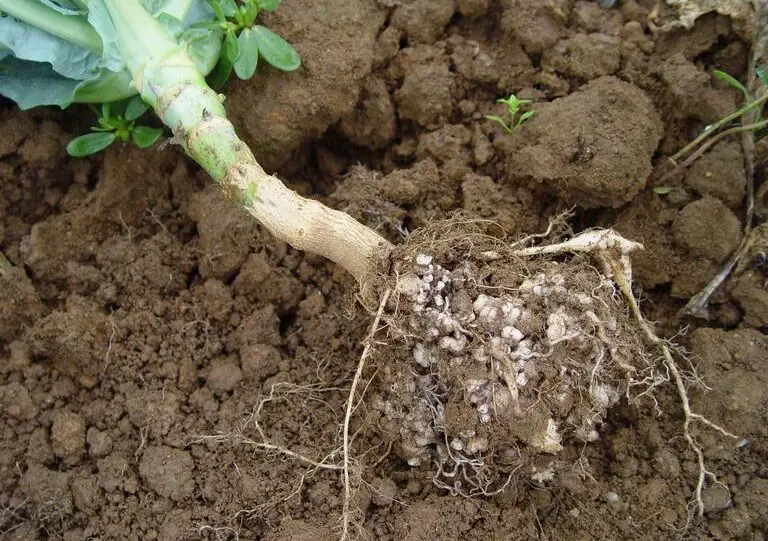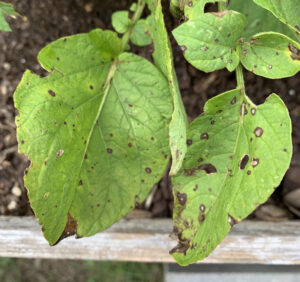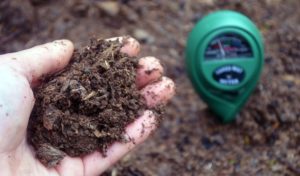Clubroot disease is a fungal disease that plagues brassicas like broccoli, cauliflower, Brussels sprouts, cabbage, turnips, mustard, kale, kohlrabi, radishes, collard greens, and more. The fungus, Plasmodiophora brassicae, spreads in the soil, infecting the roots of plants and causing them to swell and develop an irregular shape that resembles galls or clubs, hence the name. The misshaped roots are not able to absorb or transport necessary water and nutrients to the plant, resulting in wilting or yellowing leaves and stunted growth.
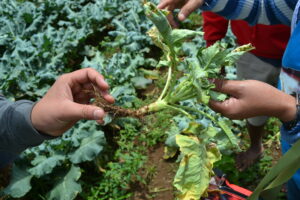
Clubroot is usually introduced to a garden via infected transplants or compost that has been insufficiently heated to kill the spores. Another way the fungus spreads is via contaminated tools and equipment. Unfortunately, before you see evidence of the disease, it has already gotten a foothold below the soil’s surface. As the roots decay, spores are released into the soil where they can lie dormant for up to twenty years. Thus, even when you pull an infected plant, the problem persists in the soil. Once the moisture in the soil reaches a certain level, the hidden spores are reactivated.
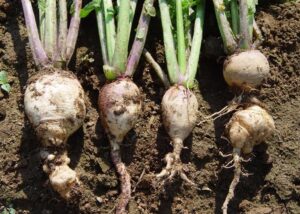
What You Should Do
If you suspect one or more of your plants has club root, dig up the plant and inspect its roots. If the roots are clubbed, pull the plant, bag it, and throw it in the trash. Do not compost the plant as most home compost piles do not reach temperatures hot enough to kill the pathogen.
How to Treat Clubroot
Prevention
Prevention is the best method of control. Purchase transplants only from trusted sources and inspect the roots as best you can before planting them in your garden.
Garden Hygiene
Practice good garden hygiene by getting in the habit of disinfecting tools, garden gloves, and equipment. Use a bleach solution made up of one part bleach to nine parts water or use one of the other options listed in this helpful article to prevent pathogens from spreading.
In addition, remove garden debris and weeds because these can harbor the spores even though they are not members of the brassica family and may, themselves, not be infected. Weeds like mustard, radish, shepherd’s purse can also carry the fungus.
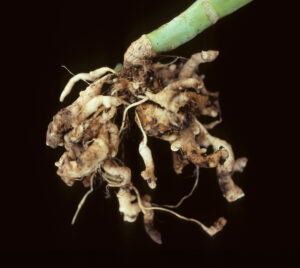
Do Not Compost Diseased Plants
Do not compost diseased plants or plant cuttings in your compost pile unless you are sure the proper temperature for killing pathogens has been maintained. You can learn more about hot composting in this article.
This article contains affiliate links. If you make a purchase using one of these links, I will receive a very small commission at no additional cost to you, and it will help me maintain this website. Rest assured, I only recommend products I actually like!
Rotate Crops
Rotate crops every year to reduce the pathogen load in the soil. Refrain for five to ten years from planting members of the brassica family (also known as the cruciferous or cole crop family) in an area that has previously experienced clubroot.
Raise Soil pH
The disease-causing fungus has a hard time thriving in acidic soil. Thus, a soil pH of 7.0 to 7.2 should help to reduce the spore population. You can purchase an inexpensive soil test kit that includes pH tests as well as tests for NPK (nitrogen, phosphorus, and potassium). Take care to plant crops that do well in alkaline soil. Here is an article on how the importance of soil pH and another on how to make the soil less acidic (i.e., more alkaline).
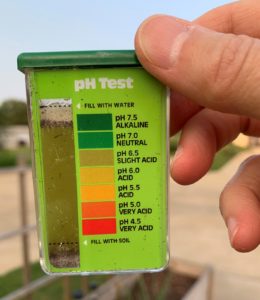
Plant Resistant Varieties
Planting clubroot-resistant varieties whenever possible can help reduce the chance of crops contracting the fungus.
Solarize the Soil
Solarization of the soil is said to reduce the presence of clubroot in the soil. To solarize the soil, during the heat of the summer, cover the area of infected soil with a clear plastic tarp for a minimum of four to six weeks. Solarization can also help reduce fungi, nematodes, insects and their eggs, weeds, and weed seeds.
Chemical Control
For those looking to use fungicides, most experts will agree that they are not effective against this pathogen. While boron is said to inhibit the infection, it can cause soil toxicity if not used in the proper amount.
Thank you for reading this article! If you found it interesting or helpful, please consider sharing it with others via email and social media!
